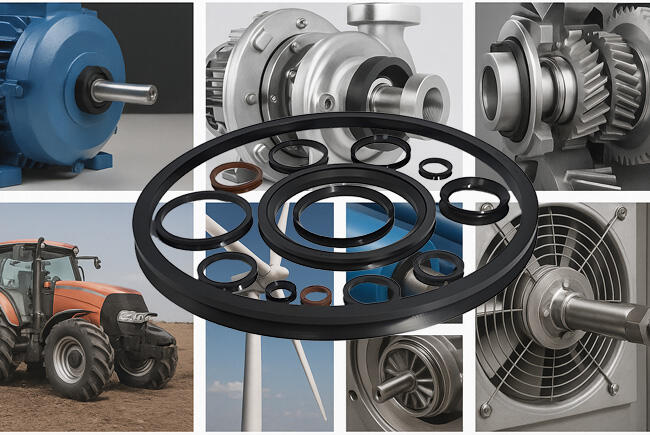When it comes to sealing rotating shafts—especially in messy environments—V-rings are one of those components that often get overlooked, but quietly do their job. The VA / VS V-ring seals in particular have proven reliable over the years, especially for applications where both grease retention and dust protection are needed without making the system overly complex.
So what exactly are they? Imagine a rubber ring, soft but shaped to hug the shaft and push against a flat surface—like the end of a bearing housing or a metal flange. They're not pressed into a groove or clamped in place; instead, they sit snugly around the shaft, rotate with it, and the lip creates a light contact with the counterface. As the shaft turns, the ring spins with it, and that light contact—plus some centrifugal force—helps flick away dust, water, and oil spray before it gets into places it shouldn’t.
Now, the VA and VS series V-rings—like the ones from NQKSF—are built with a bit more in mind. One issue engineers often face is misalignment: the shaft isn’t always perfectly centered. These V-rings can handle that. The lip is forgiving, meaning even if the shaft wobbles a little or shifts axially, the seal still holds. That flexibility gives them a bit of a “set it and forget it” appeal.
NQKSF has been producing these for decades. They use either NBR (for standard oil resistance and general use) or FKM (when you’re dealing with high heat, harsh chemicals, or dusty outdoor setups). Either way, the material quality is solid. There’s minimal friction when running dry, and at lower speeds, they barely generate heat. That can make a difference if you're trying to reduce wear over the long run.
And speaking of long run—maintenance is where these seals really shine. You don’t need fancy tools to get them on. Just slide them over the shaft. If you ever need to swap one out, no need to tear down the entire housing. That alone can save hours in the field.
Here are some places you’ll typically see them: electric motors, small gearboxes, ag machinery like harvesters, construction equipment like diggers, and even wind turbines (those pitch control mechanisms take a beating). Anywhere there's a shaft moving and contaminants nearby, V-rings offer cheap insurance.

A couple of things to keep in mind if you're installing them: make sure the mating surface is smooth—no burrs or sharp edges. They're not meant to be submerged in oil; they work best as auxiliary seals, paired with something like a labyrinth or radial seal. If you need to keep grease in and dust out at the same time, sometimes it helps to install one facing in and one facing out.
Now, NQKSF isn’t just another name in the business. We’ve got over 10,000 models in stock, so you’re not waiting weeks for a common size. And if you’re working on something unusual, we can customize—starting from material selection all the way to test verification. Their engineers aren’t just selling parts; they’ll help you with selection and failure analysis too, if needed.
They’ve been around for over 30 years, with manufacturing, R&D, and sales integrated under one roof. More importantly, they’ve earned the trust of a lot of OEMs in machinery, power generation, and transport. Not just in China, but across more than 80 countries.
Choosing the right V-ring might seem minor, but it often ends up being the quiet reason your system keeps running without a hitch.
 Hot News
Hot News